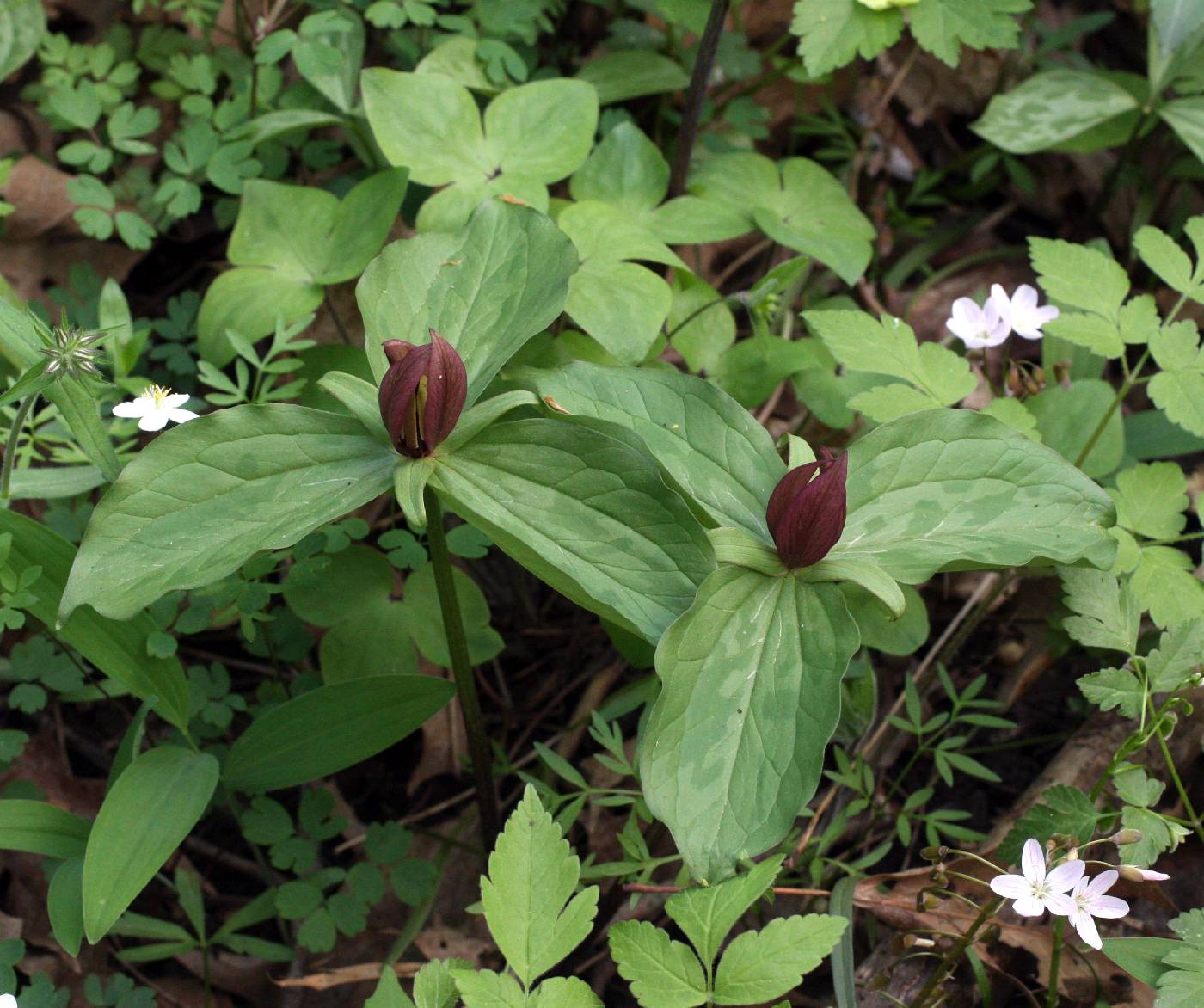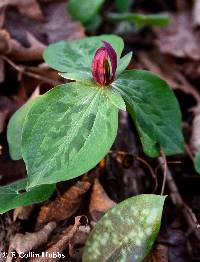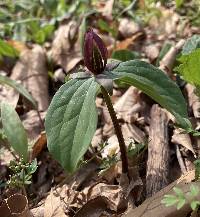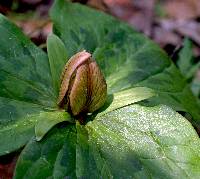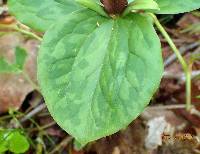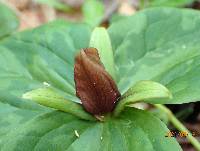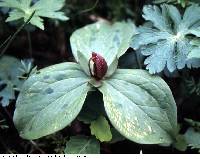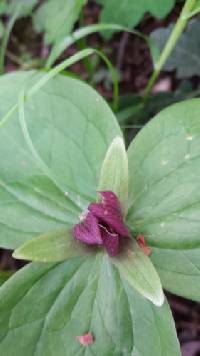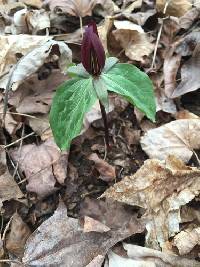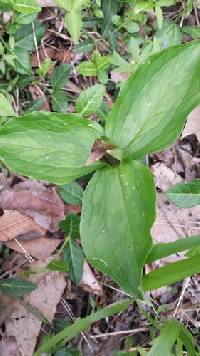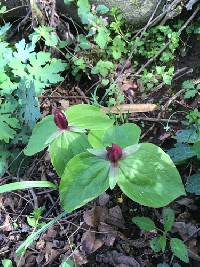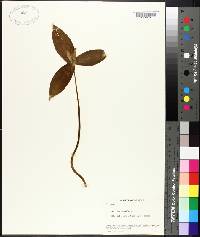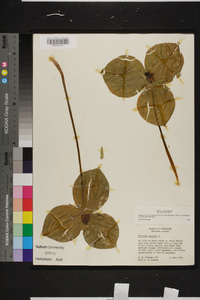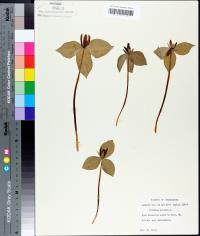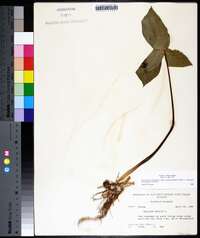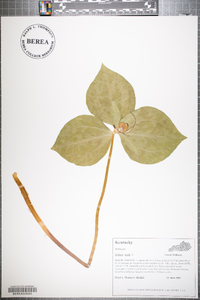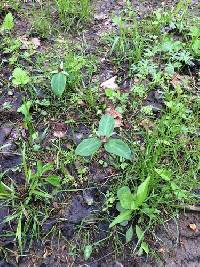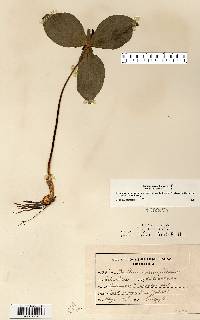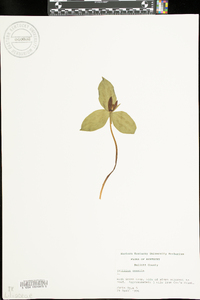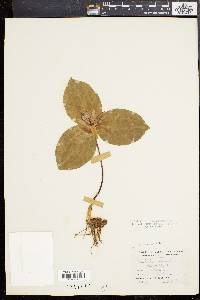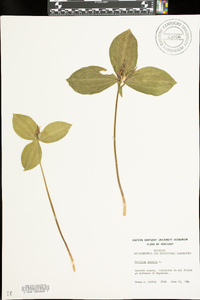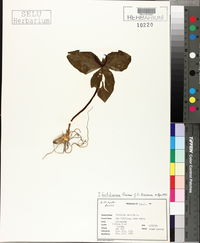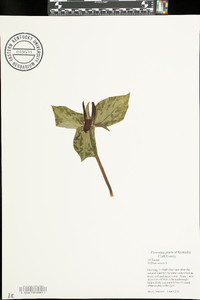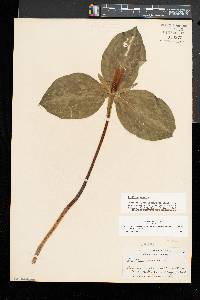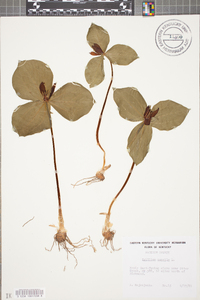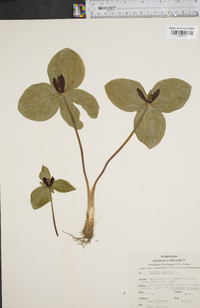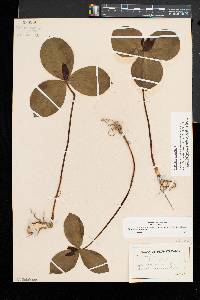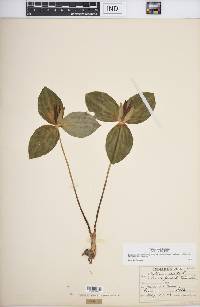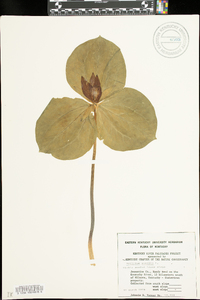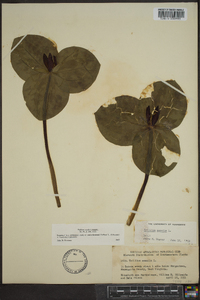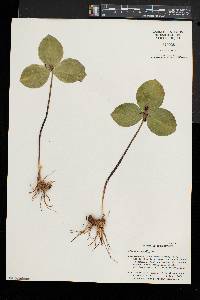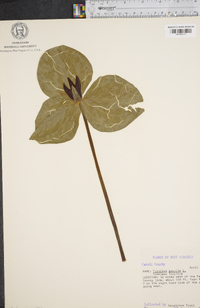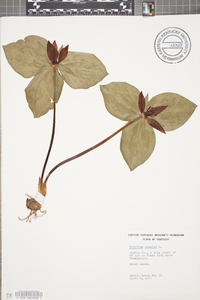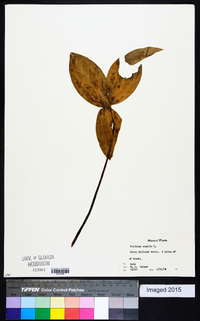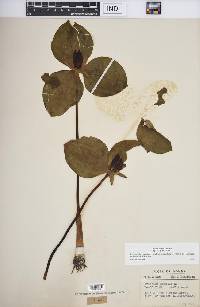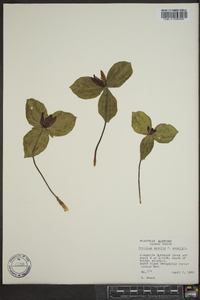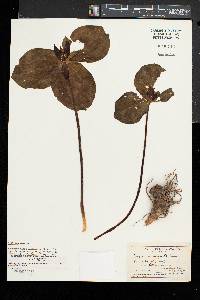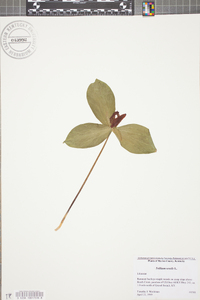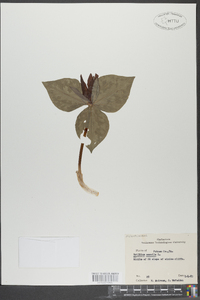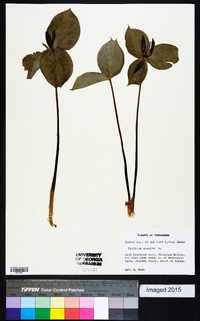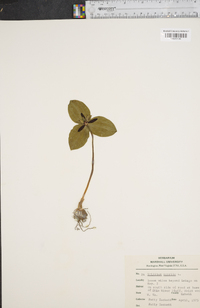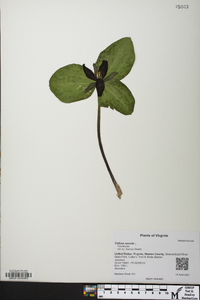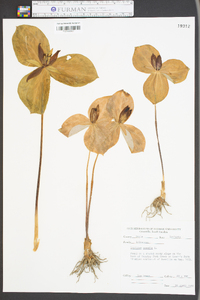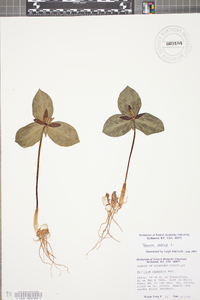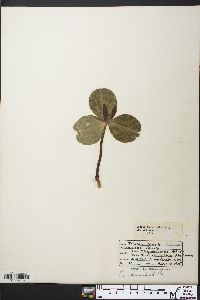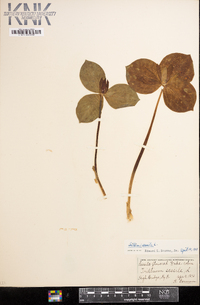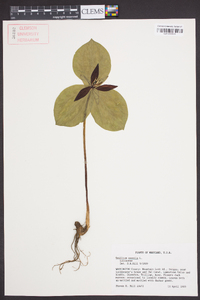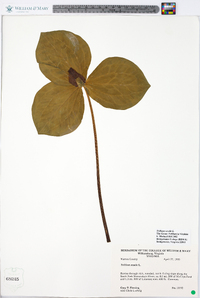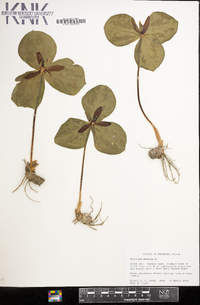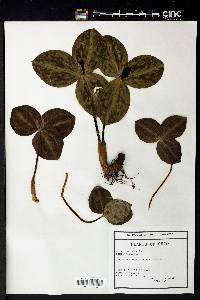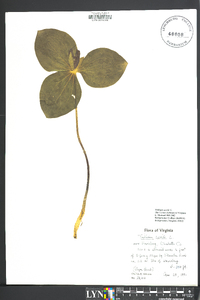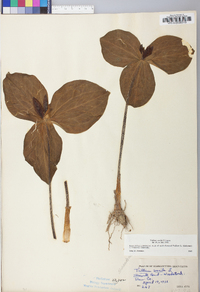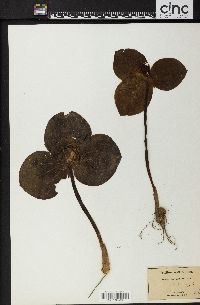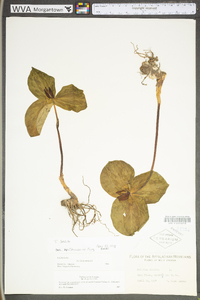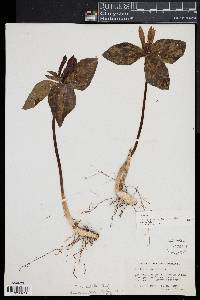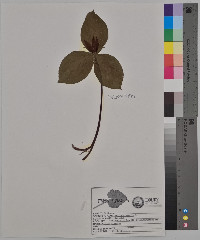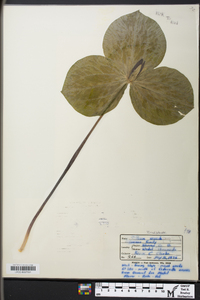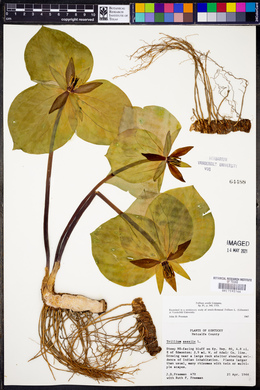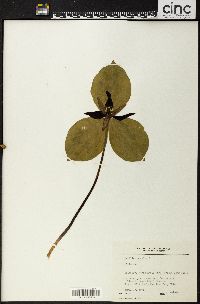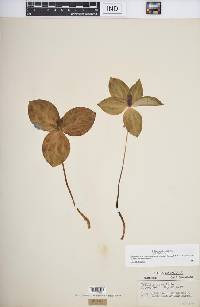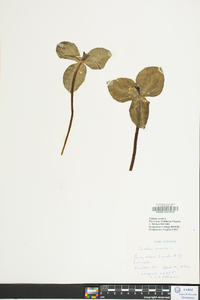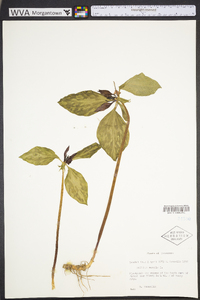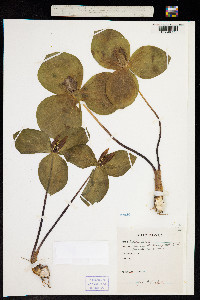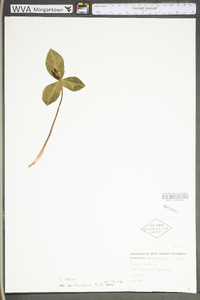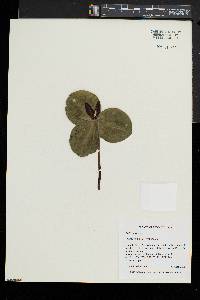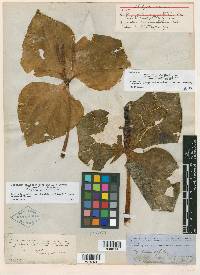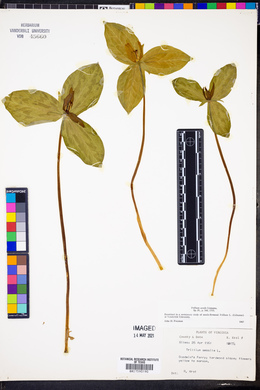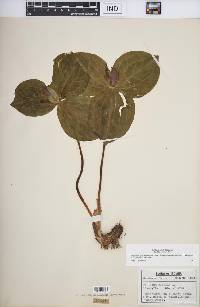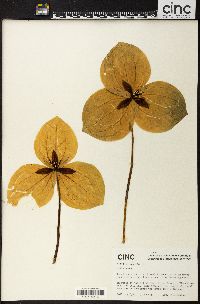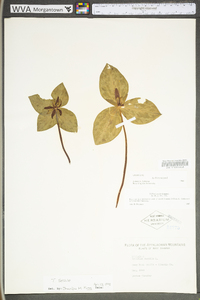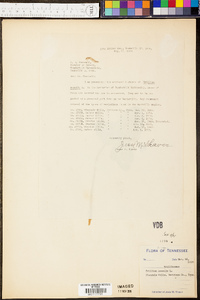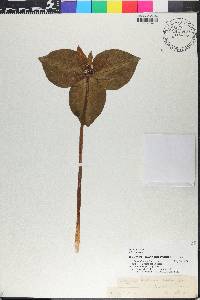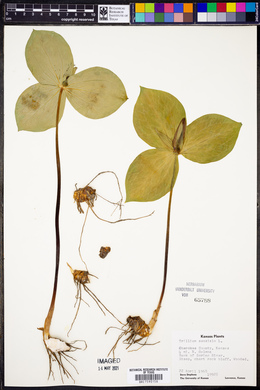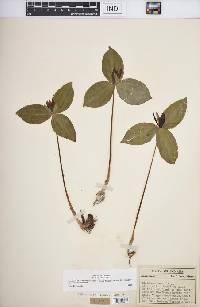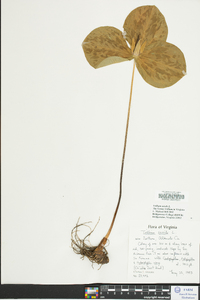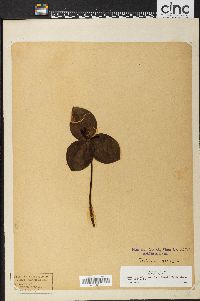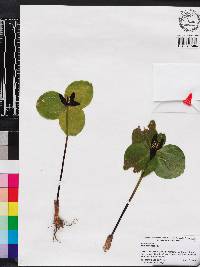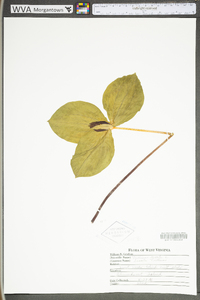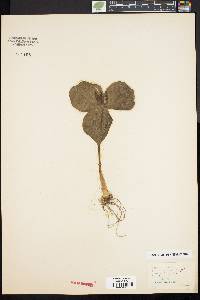
|
|
|
|
Family: Melanthiaceae
Toadshade
[Trillium sessile f. viridiflorum Beyer] |
Rhizomes horizontal, brownish, thick, praemorse, fleshy. Scapes 1-3, round in cross section, 0.8-2.5 dm, slender to stout, glabrous. Bracts held well above ground, sessile; blade green to bluish green, strongly to sparsely mottled, mottling becoming obscure with age, oval to suborbicular, 4-10 × 2-8 cm, base broadly attached, apex rounded-acuminate to bluntly parallel sided-acuminate (rounded basally to its broad attachment). Flower erect, odor pungent, spicy; sepals displayed above bracts, spreading, green, variously streaked with maroon, lanceolate-oblanceolate, 9-35 × 4-8 mm, margins entire, apex rounded-acuminate; petals long-lasting, erect, ± connivent, ± concealing stamens and ovary, maroon, brownish maroon, green, or yellowish green, not spirally twisted, oblanceolate to elliptic, occasionally almost orbicular, 1.7-3.5 × 0.7-2 cm, thick-textured, narrowed near basal attachment (but not truly clawed), margins entire, apex gradually rounded-tapered to acute; stamens straight, 10-23 mm; filaments red-purple, 2-5 mm, dilated basally; anthers erect, straight, gray-purple, 9-16 mm, thick, dehiscence introrse; connectives purplish brown, straight, projecting 2-5+ mm beyond anther sacs; ovary greenish white basally, purple distally, ovoid to globose, 6-angled, pyramidally narrowed to stigmas, 4-8.5 mm; stigmas erect, divergent-recurved, distinct, purple, subulate, 1-5 mm, ± fleshy. Fruits baccate, dark greenish purple, odorless, subglobose, 6-angled, angles somewhat winglike, pulpy, not juicy. 2n = 10. Flowering spring (Mar--early May). Rich woodlands, limestone districts, calcareous soils, floodplains, riverbanks, clayey alluvium, less fertile soils, high, dry limestone woods, persists under light pasturing, in fencerows and brushy areas after lumbering; 100--300 m; Ala., Ark., Ill., Ind., Kans., Ky., Md., Mich., Mo., N.Y., N.C., Ohio, Okla., Pa., Tenn., Va., W.Va. Trillium sessile is rather uniform throughout its range, with few color forms.
Perennial herb with a short, stout rhizome stem 10 - 30 cm tall Flowers: single, upright, stalkless, with six distinct tepals, bad-smelling. Stamens six, alternating in two whorls of three. Sepals: three, persistent, streaked with maroon, 9 mm - 3.5 cm long, 4 - 8 mm wide, more or less equal to the petals, lance- to egg-shaped, spreading or ascending. Petals: three, maroon (sometimes green to yellow), 1.7 - 3.5 cm long, 0.7 - 2 cm wide, narrowly to broadly elliptic with a tapering base, ascending, more or less concealing the stamens and ovary, long-lasting. Fruit: a many-seeded berry, dark greenish purple, nearly spherical, six-angled (somewhat wing-like), pulpy. Seeds many, elliptic. Similar species: This Trillium species is easily distinguished from the others by having stalkless leaves and a stalkless flower. Flowering: mid-April to mid-May Habitat and ecology: Rare in the Chicago Region, found in rich moist woods. Occurence in the Chicago region: native Notes: Trilliums do not actually have true leaves or stems above the ground. The underground rhizome produces scale-like leaves called cataphylls. The aboveground leaf-like structures are bracts that subtend the flower, but these are internally and externally similar to leaves and function in photosynthesis. Many authors will refer to them as leaves. Etymology: Trillium comes from the Greek word trilix, meaning triple, referring to how all the plant parts occur in threes. Sessile means stalkless. Author: The Morton Arboretum Rhizome very thick and stout; stem 1-3 dm at anthesis; lvs broadly ovate to rotund, sessile, rounded, broadly obtuse or obscurely cuspidate, usually only inconspicuously or not at all mottled, seldom over 9 cm at anthesis; fl sessile, foetid; sep spreading or ascending, lance-ovate, 2-3 cm; pet normally maroon (yellow or green), ascending, narrowly to broadly elliptic, narrowed to a sessile base, equaling or slightly longer than the sep and twice as long as the stamens; filaments (2-)3-4(-5) mm, less than half as long as the introrse anthers, the flattened connective with a prolongation nearly as long as the filament; stigmas 1.5-2 times as long as the subglobose, sharply 6-angled or -winged ovary; 2n=10. Rich moist woods; w. Pa. and sw. N.Y. to s. Mich., Ill., Mo., and e. Kans., s. to Md., Va., n. N.C., n. Ala., and n. Ark. Apr., May. Gleason, Henry A. & Cronquist, Arthur J. 1991. Manual of vascular plants of northeastern United States and adjacent Canada. lxxv + 910 pp. ©The New York Botanical Garden. All rights reserved. Used by permission. From Flora of Indiana (1940) by Charles C. Deam Infrequent to frequent throughout the greater part of the state, but becoming rare to absent in the southwestern counties. It is found mostly in rich, moist woods. I have had plants with 4 and 5 leaves and one with greenish yellow petals under cultivation and they have come true for at least 10 years. I also have plants with 2 and 3 stems from the same rootstock. In one instance one stem has 3 leaves and the other has 4 leaves. …… Indiana Coefficient of Conservatism: C = 4 Wetland Indicator Status: FACU |
|
|
|

